当前位置:
X-MOL 学术
›
Acta Mater.
›
论文详情
Our official English website, www.x-mol.net, welcomes your
feedback! (Note: you will need to create a separate account there.)
Mixed atomic-scale electronic configuration as a strategy to avoid cocatalyst utilization in photocatalysis by high-entropy oxides
Acta Materialia ( IF 8.3 ) Pub Date : 2024-11-10 , DOI: 10.1016/j.actamat.2024.120559 Jacqueline Hidalgo-Jiménez, Taner Akbay, Xavier Sauvage, Tatsumi Ishihara, Kaveh Edalati
Acta Materialia ( IF 8.3 ) Pub Date : 2024-11-10 , DOI: 10.1016/j.actamat.2024.120559 Jacqueline Hidalgo-Jiménez, Taner Akbay, Xavier Sauvage, Tatsumi Ishihara, Kaveh Edalati

|
To enhance the activity of photocatalysts for hydrogen production and CO2 conversion, noble metal cocatalysts as electron traps and/or acceptors such as platinum or gold are usually utilized. This study hypothesizes that mixing elements with heterogeneous electronic configurations and diverse electronegativities can provide both acceptor and donor sites of electrons to avoid using cocatalysts. This hypothesis was examined in high-entropy oxides (HEOs), which show high flexibility for atomic-scale compositional changes by keeping their single- or dual-phase structure. A new high-entropy oxide was designed and synthesized by mixing elements with an empty d orbital (titanium, zirconium, niobium and tantalum) and a fully occupied d orbital (gallium). The oxide, synthesized by high-pressure torsion followed by calcination, had two phases (88 wt% orthorhombic (Pbcn ) and 12 wt% monoclinic (I2/m )) with an overall composition of TiZrNbTaGaO10.5 . It exhibited UV and visible light absorbance with a low bandgap of 2.5 eV, low radiative electron-hole recombination and oxygen vacancy generation due to mixed valences of cations. It successfully acted as a photocatalyst for CO and CH4 production from CO2 conversion and hydrogen production from water splitting without cocatalyst addition. These findings confirm that introducing heterogeneous electronic configurations and electronegativities can be considered as a design criterion to avoid the need to use cocatalysts.
中文翻译:

混合原子级电子构型作为避免高熵氧化物在光催化中使用助催化剂的策略
为了增强光催化剂在制氢和 CO2 转化中的活性,通常使用贵金属助催化剂作为电子陷阱和/或受体,如铂或金。本研究假设混合具有异质电子构型和不同电负性的元素可以提供电子的受体和供体位点,以避免使用助催化剂。这一假设在高熵氧化物 (HEO) 中进行了检验,高熵氧化物通过保持其单相或双相结构,在原子尺度成分变化方面表现出高度的灵活性。通过将具有空 d 轨道(钛、锆、铌和钽)的元素混合来设计和合成一种新的高熵氧化物,该轨道具有完全占据的 d 轨道(镓)。通过高压扭转后煅烧合成的氧化物具有两相(88 wt% 正交 (Pbcn) 和 12 wt% 单斜晶系 (I2/m)),总组成为 TiZrNbTaGaO10.5。它表现出紫外和可见光吸光度,具有 2.5 eV 的低带隙、低辐射电子空穴复合和由于阳离子的混合价而产生的氧空位。它成功地作为光催化剂,用于 CO2 转化产生 CO 和 CH4 以及水分解产生氢气,而无需添加助催化剂。这些发现证实,引入异质电子构型和电负性可以被视为避免使用助催化剂的设计标准。
更新日期:2024-11-10
中文翻译:

混合原子级电子构型作为避免高熵氧化物在光催化中使用助催化剂的策略
为了增强光催化剂在制氢和 CO2 转化中的活性,通常使用贵金属助催化剂作为电子陷阱和/或受体,如铂或金。本研究假设混合具有异质电子构型和不同电负性的元素可以提供电子的受体和供体位点,以避免使用助催化剂。这一假设在高熵氧化物 (HEO) 中进行了检验,高熵氧化物通过保持其单相或双相结构,在原子尺度成分变化方面表现出高度的灵活性。通过将具有空 d 轨道(钛、锆、铌和钽)的元素混合来设计和合成一种新的高熵氧化物,该轨道具有完全占据的 d 轨道(镓)。通过高压扭转后煅烧合成的氧化物具有两相(88 wt% 正交 (Pbcn) 和 12 wt% 单斜晶系 (I2/m)),总组成为 TiZrNbTaGaO10.5。它表现出紫外和可见光吸光度,具有 2.5 eV 的低带隙、低辐射电子空穴复合和由于阳离子的混合价而产生的氧空位。它成功地作为光催化剂,用于 CO2 转化产生 CO 和 CH4 以及水分解产生氢气,而无需添加助催化剂。这些发现证实,引入异质电子构型和电负性可以被视为避免使用助催化剂的设计标准。


















































 京公网安备 11010802027423号
京公网安备 11010802027423号